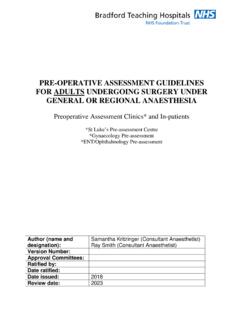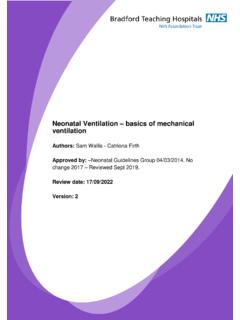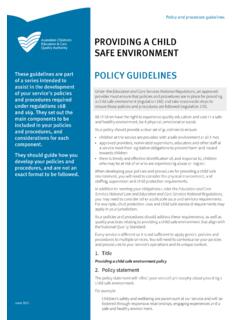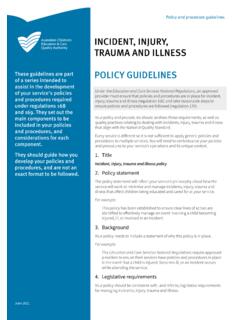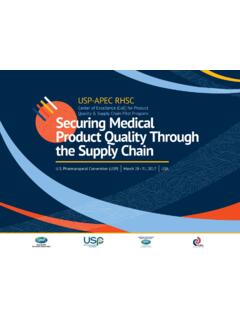Transcription of Guidelines for the Warming of IV and Irrigation Fluids
1 Guidelines FOR THE Warming OF IV. AND Irrigation Fluids . Authors (name and designation) Lee Watkinson Deputy Quality Assurance Manager Version 3. Supersedes Version 2. Approval Committee Drug and Therapeutics Committee Date approved 14th August 2018. Date issued 14th August 2018. Review date August 2020. Page | 1. CONTENTS. SECTION PAGE. 1 Introduction 3. 2 Purpose and Scope of Guidelines 3. 3 Definitions as per NICE Guidelines 3. 4 Warming Cabinets 3. 5 Storage of IV Fluids 4. 6 Storage of Irrigation Fluids 4. 7 When things go wrong 5. 8 References 5. Appendix 1 Maximum storage lengths 5. ** Please attach a copy of Appendix 1 to the front of your Warming cabinet as a reference. Page | 2. 1. Introduction These Guidelines have been written in response to NICE clinical guideline 65 - Inadvertent perioperative hypothermia - The management of inadvertent perioperative hypothermia in adults.
2 Compliance with these Guidelines is every member of staff's responsibility. 2. Purpose and Scope of these Guidelines These Guidelines are intended to provide guidance to all staff on the Warming and storage of IV Fluids and Irrigation solutions. The purpose of these Guidelines is to: Ensure that all Fluids are warmed and stored correctly Protect patients from inadvertent perioperative hypothermia. 3. Definitions as per NICE Guidelines Hypothermia: For the purpose of this guideline, hypothermia is defined as a core temperature less than C ( F). Severity of hypothermia was defined as follows: mild hypothermia: core temperature C to C;. moderate: C to C severe: C. Perioperative pertaining or relating to the period of time surrounding a surgical procedure, including the preoperative, intraoperative, and postoperative periods.
3 Inadvertent unintentional. 4. Warming Cabinets Only IV Fluids or Irrigation Fluids should be stored in the Warming cabinet. Regular Stock checks and stock rotation should be performed. The temperature of the Warming cabinet should be monitored using a separate maximum/minimum digital thermometer to the in-built cabinet thermometer. The current, maximum and minimum temperatures should be recorded at least once daily and any excursions should be investigated. The thermometer should be reset/memory cleared after the temperatures have been recorded each day. The cabinet must be regularly serviced and maintained in accordance with the manufacturer's instructions and a record kept supporting this. All staff using the Warming cabinet must be trained in its use. The Warming cabinet must comply with infection control standards.
4 Regular unannounced audits can be carried out by Pharmacy or an appointed member of staff or department. Advice on temperature monitoring can be sought from Quality Control Pharmacy, ext 4241. Page | 3. NOTE Microwave ovens must not be used for Warming IV Fluids or Irrigation Fluids . 5. Storage of IV Fluids in a Warming Cabinet All intravenous Fluids (500ml or more) used intraoperatively should be warmed to a temperature of 37oC (temperature must not exceed 40oC). IV Fluids should be kept in their over pouches until the point of use. Minimal stocks of each type of IV fluid should be kept in the cabinet at any one time. A stock list should be produced to ensure sufficient stock available at all times. Stock checks should be performed and stock should be rotated regularly, and expiry checks completed.
5 IV fluid over pouches should be marked with permanent marker to identify the date they were put in the Warming cabinet, and the date they need to be removed. Best practice is to use a permanent marker as labels can be removed or fall off. IV Fluids should not be subsequently returned to the Warming cabinet once removed, using a permanent marker on the IV fluid over pouches ensures products will not be returned to the cabinet. Length of storage is dependent on container type; please see Appendix 1 for specific container storage length information. 6. Storage of Irrigation Fluids in a Warming Cabinet All Irrigation Fluids used intraoperatively should be warmed to a temperature of 38 to 40oC. Only unopened Irrigation fluid containers should to be warmed. Once opened they should be discarded as they are no longer sterile.
6 A small stock of Irrigation Fluids should be kept in the Warming cabinet in case of emergency surgery, a stock list should be produced to ensure sufficient stock is available at all times. Extra stock can be added to the cabinet and date marked, when procedures identified as requiring warmed Irrigation Fluids are to be performed. Irrigation Fluids should be marked with permanent marker to identify the date (and time for Baxter Plastic Pour Bottles) they were put into the cabinet, and when they need to be removed. Irrigation Fluids should not be subsequently returned to the Warming cabinet. Using permanent marker will help to identify they have been previously warmed. Stock checks should be performed and stock should be rotated regularly, and expiry checks completed. Length of storage is dependent on the type of Irrigation fluid and container type; please see Appendix 1 for specific storage length information of different containers and Fluids .
7 Page | 4. 7. When things go wrong Where an incident or near miss occurs this should be reported, managed and investigated in accordance with the Foundation Trust's Risk Incident and Reporting Policy. Regular audits will also take place. 8. References 1. NICE clinical guideline 65; Inadvertent perioperative hypothermia; The management of inadvertent perioperative hypothermia in adults, NICE, April 2008. Updated 2011 and 2015. Appendix 1- These storage conditions apply to all baxter Fluids kept in the following containers. 500ml Sodium Chloride in a Baxter Viaflo container can be stored for 7 weeks at 40oC before being removed and put back into stock. Type of container- Maximum Maximum storage Can be used up to individual Fluids should storage length temperature when expiry date on be checked to when warmed warmed container if determine the container previously warmed?
8 They are in. Baxter Viaflo 500mL 7 weeks 40oC Yes. Do not return to the warmer. Baxter Viaflo 1000mL 14 weeks 40oC Yes. Do not return to the warmer. Baxter Viaflex 500mL 2 weeks 40oC Yes. Do not return to the warmer. Baxter Viaflex 1000mL 2 weeks 40oC Yes. Do not return to the warmer. Baxter Uromatic Irrigation 2 weeks 45oC Yes. Do not return to Solutions the warmer. Baxter Easyflow Irrigation 2 weeks 45oC Yes. Do not return to Solutions the warmer. Baxter Plastic Pour 72 hours 65oC Yes, if unopened. Do Bottles not return to the warmer. B Braun Gelofusine 3 months 40oC No. Discard. 500mL Ecobag Fresenius Kabi Flowfusor 1 month 40oC No. Discard bottles 1000ml & 2000ml Fresenius Kabi Bags 3 Months 40oC No. Discard various sizes. Solutions containing glucose/dextrose Fresenius Kabi Bags 6 Months 40oC No.
9 Discard various sizes. Solutions Free from glucose/dextrose Page | 5. Please contact Medicines Information ext 4598 for information on any Fluids kept that are not on this list. Warming Cabinet Monitoring Chart The temperature of the cabinet should be recorded every day. Once temperatures have been recorded, reset / memory clear the maximum and minimum temperature on the thermometer. Any issues please contact QC pharmacy on 4241. Ward/ Department Cabinet Location . Month .. 20 . Date Time Current Max Min Checked Thermometer Comments/Action C C C by: Reset/ memory cleared Page | 6. Page | 7.
